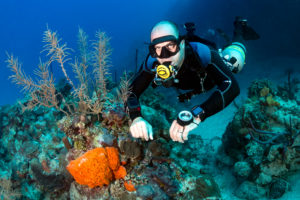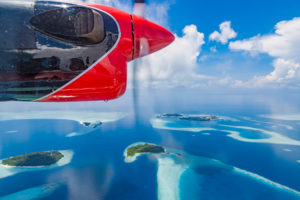Though it feels like we’ve had them forever, dive computers only came into common usage around the time the first Blackberry launched. If you consider how far smartphone technology has come in the intervening years, you might question why we’re not using some kind of gill implants yet. Gills aside, the world of diving is changing just as rapidly as the tech it uses. Here are our picks for some trends in scuba diving to watch out for.
Say what?
In terms of a trend to watch, bluetooth communication technology and underwater communication might see some significant advances. Hand signals, rattles, bangers, and air horns are rather pedestrian means of communication in a uber-connected topside world, though many would argue that one of the most pleasurable aspects of diving is the respite it offers from the clamor of dry land.
Buddy Watcher tries to keep the peace. This wrist-mounted device silently buzzes your buddy using ultrasound technology to create a vibration.
Oceans S1, a dive computer that incorporates buddy communication, just smashed its Kickstarter launch goal. As well as giving you all the standard dive data, you can also ‘ping’ other users with soundless ultrasonic waves to get their attention.
Now you’re talking

These inventions are still quite a way from holding a conversation underwater — which is where the full-face mask comes in. Commercial divers, research teams, filmmakers, and public safety divers have been using full-face masks and talking to their colleagues for years. Only now is the full-face mask beginning to appear in recreational diving. Costs are quite high — masks range from $600 to $1,600 — and communications devices are around $500. Training to use both is around $500 as well. Increased popularity will drive the price down and could create some fundamental changes in how we communicate while diving.
Configurations

The sidemount configuration has been another crossover from technical diving. Originally developed by cave divers to streamline and offer better access to their gear, sidemount exploded into open-water diving. Not only has the streamlined comfort made it attractive to recreational divers, the gear is also more suitable for travel. It offers relief to those with knee or back problems, and it makes wobbling around a dive boat with heavy gear a thing of the past. Recent agency changes allow for entry-level certification in sidemount as well. The growth of this configuration, for now, will come from existing divers looking for comfort and better streamlining, so it’s certainly going to become more commonplace on the boat.
Recycling isn’t just for sustainable consumerism
Rebreather diving was a game changer for technical divers. The ability to recycle your gas supply and breathe the optimal mix for different depths increased dive times and decreased helium costs, making longer exploration dives a reality. The cost and overly-technical nature of these units has prohibited most recreational divers from considering them, but as simpler, more affordable units launch to appeal to the recreational market, dive agencies have followed suit with training. Apart from increased bottom time, a rebreather allows the diver unparalleled interaction with marine life, which makes these units hugely popular with photographers and videographers. Cost-wise they are on par with the more-expensive camera setups.
Exploring remote dive destinations

With faster air travel and more connections, another trend in scuba diving will be the relative ease of exploring remoter dive destinations. Many European dive spots, the Maldives, and Red Sea resorts are accessible within a full day’s travel. Most Caribbean Islands now have international airports, and even previously remote destinations in Indonesia such as Raja Ampat and Komodo have seen dive visitors rise exponentially in recent years. Far-flung destinations such as Timor-Leste and Ambon/Banda Sea in Indonesia, scuba diving in Argentina’s Patagonia region and customized cruises with snorkeling options to Antarctica are becoming more popular as well.
Eco-diving
The BBC’s “Blue Planet II” brought ocean health into the mainstream. It has driven debate and accelerated reforms, and it’s also created an increased desire to help preserve the ocean. Divers are looking for more involvement rather than just passive enjoyment, and eco-programs are on the rise.
In a future post, we’ll look further into eco-diving and voluntourism, and how you can get involved in the ocean’s future and come away from your next diving vacation with more than memories.

